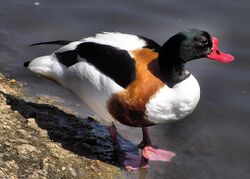Biology:Tadorninae
| Tadorninae | |
|---|---|

| |
| Common shelduck (Tadorna tadorna) | |
| Scientific classification | |
| Domain: | Eukaryota |
| Kingdom: | Animalia |
| Phylum: | Chordata |
| Class: | Aves |
| Order: | Anseriformes |
| Family: | Anatidae |
| Subfamily: | Tadorninae Reichenbach, 1849 |
| Genera | |
|
see article text | |
The Tadorninae is the shelduck-sheldgoose subfamily of the Anatidae, the biological family that includes the ducks and most duck-like waterfowl such as the geese and swans.
This group is largely tropical or Southern Hemisphere in distribution, with only two species, the common shelduck and the ruddy shelduck breeding in northern temperate regions, though the crested shelduck (presumed extinct) was also a northern species.
Most of these species have a distinctive plumage, but there is no pattern as to whether the sexes are alike, even within a single genus.
Systematics
Following the review of Livezey (1986),[1] several species formerly classified as aberrant dabbling ducks or as "perching ducks" were placed in the Tadorninae. mtDNA sequence analyses[2][3] cast doubt on the allocation of several genera; many supposed dabbling ducks and one peculiar goose may more correctly belong here, while some genera believed to be close to shelducks appear to have different relationships altogether.
The available data indicates that the Tadorninae are indeed, as their appearance suggests, somewhat intermediate between geese and dabbling ducks, but the molecular data suggests they are not the only lineage to evolve towards a more duck-like morphology, with the diving ducks and seaducks being more distant.
Family Anatidae
Subfamily Tadorninae
- Unequivocally placed in this group:
- Tadorna: shelducks (Europe, Africa, Australasia; 6 species) – possibly paraphyletic
- Radjah: Radjah shelduck (Australia, New Guinea)
- Centrornis: Madagascar sheldgoose (Madagascar, prehistoric)
- Alopochen: Egyptian goose, and extinct African and Mascarene shelducks (Africa and Madagascar region; 1 living species, 2–3 extinct)
- Neochen: Orinoco goose and Andean goose (South America)
- Chloephaga: sheldgeese (South America; 4 species)
- Hymenolaimus: blue duck (New Zealand)—formerly in "perching ducks"
- Merganetta: torrent duck (Andes mountains, South America) – formerly in "perching ducks"
- Provisionally placed in this group:
- Malacorhynchus: pink-eared ducks (Australia; 1 living species, 1 prehistoric) – may be closer to Oxyurinae
- Cyanochen: blue-winged goose (Ethiopia) – may belong to a distinct subfamily
- Tachyeres: steamer ducks (South America; 4 species) – may belong to Anatinae
- Plectropterus: spur-winged goose (sub-Saharan Africa) – may be in monotypic subfamily
- May belong to Tadorninae, currently placed elsewhere:
- Aix: Mandarin duck and wood duck (East Asia and North America, respectively)
- Cairina moschata: Muscovy duck (tropical America; genus Cairina may be paraphyletic)
- Cereopsis: Cape Barren goose (Australia)
- Callonetta: ringed teal (South America)
- Chenonetta: maned duck (Australia and formerly New Zealand; 1 living species, 1 extinct)
- Salvadorina: Salvadori's teal (New Guinea)—formerly in Anatidae and "perching ducks"
References
| Wikimedia Commons has media related to Tadorninae. |
- ↑ Livezey, Bradley C. (1986). "A phylogenetic analysis of recent anseriform genera using morphological characters". Auk 103 (4): 737–754. http://sora.unm.edu/sites/default/files/journals/auk/v103n04/p0737-p0754.pdf.
- ↑ Sraml, M.; Christidis, L.; Easteal, S.; Horn, P.; Collet, C. (1996). "Molecular Relationships Within Australasian Waterfowl (Anseriformes)". Australian Journal of Zoology 44 (1): 47–58. doi:10.1071/ZO9960047.
- ↑ Johnson, Kevin P.; Sorenson, Michael D. (1999). "Phylogeny and biogeography of dabbling ducks (genus Anas): a comparison of molecular and morphological evidence". Auk 116 (3): 792–805. doi:10.2307/4089339. http://sora.unm.edu/sites/default/files/journals/auk/v116n03/p0792-p0805.pdf.
Wikidata ☰ Q21153 entry
 |

